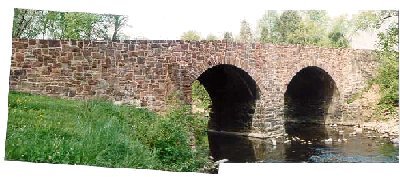
Second Manassas - Part 4

15th Georgia
This is the view from Henry House Hill south of the visitors' center looking toward the Manassas-Sudley Road. The 15th Georgia of Benning's brigade reached the road, pushing back Milroy's brigade and two regiments of Reynold's division. Monroe's battery, which was in the area to the left of the paved driveway, fired canister into the Confederates, but retired to avoid the rifle fire.
The Union line extended 5,000 feet south along the Manassas-Sudley Road, toward the left of the picture. The belt of woods on the left half of the picture stretched between Henry House Hill and a clearing further south. Chapman's brigade of regulars extended through this belt of woods to the clearing where they were the far left of the Union line. A company of the 11th US Regiment in the woods disturbed a hornets nest and briefly put the men to flight until officers restored order.
 \
\
Union Line Flanked
Chapman's brigade on the far left flank was positioned along the road in the area of the entrance to a modern community college, and it was relieved by part of Buchanan's brigade. R.H. Anderson's division attacked this line from across the road on the left of the picture, with G.T. Anderson's brigade supported by Wright's brigade attacking frontally while Mahone's brigade and Eshelman's battery crossed the road somewhere behind the cameraman and flanked the Union line. The flank attack was not pressed as it should have been, but the Union line here was eventually withdrawn back to Henry House Hill. A Confederate attack on the hill from here along the axis of the road was repulsed as the day was drawing to a close.
Back at Henry House Hill, the two other regiments of Buchanan's brigade and the a regiment of Piatt's brigade counterattacked the right flank of Benning's brigade, pushing them back and forcing the 15th Ga. to withdraw from the road. After 20 minutes of rifle and canister fire, Benning's left also fell back. The fighting continued until dark, but prospects of further Confederate success dimmed.

From Portici
General John Buford had used his cavalry to protect the Union left flank and had fallen back along the Old Warrenton, Alexandria & Washington Road to a point near Portici, which had been Confederate headquarters during the First Battle of Manassas. The brigade deployed with two regiments in the front line and regiments in a supporting line on the left side of the ridge visible in the center of the picture.
Beverly Robertson's Confederate cavalry had pushed forward on Longstreet's right flank. Because most of Buford's command was hidden behind the ridge, Robertson ordered just one regiment, the 2nd Va. Cavalry, to push the Yankees back. Munford's 2nd Va. reached the ridgetop and saw Buford's brigade beginning to charge them. Munford mounted his own desperate charge but was forced back, the first such event in the history of Stuart's cavalry. Robertson now attacked with his whole brigade, and the Union cavalry began to waver, then fall back. Robertson pursued across Bull Run, marked roughly by the distant treeline on the left half of the panorama, specifically at Lewis Ford, but he did not press his pursuit. Had Robertson advanced to the Warrenton Turnpike in the Union rear, he could have struck the Union wagons and fleeing infantry and turned the battle into a crushing victory.

Stone Bridge
During the night, Pope withdrew this army across Bull Run over the Stone Bridge, which was then destroyed. The stone arches had been destroyed in the spring, which had been replaced by wooden spans. Longstreet's attack had cost around 3,000 men in course of a few hours but had very nearly succeeded in destroying Pope's Army of Virginia. Jackson had suffered equal losses over the course of three days. Over the course of the campaign, Lee had lost around 8,000 men versus around 14,000 Union losses.
Another attempt to encircle the Union army failed at Chantilly, or Ox Hill, and Lee's best opportunity to destroy a Union army was gone forever. But since June Lee had reversed the momentum of the war in Virginia and pushed the Yankees out of the state. He now planned to continue the momentum and carry the war to the north, and in September it would be his turn to face near annihilation along Antietam Creek.
Back to Second Manassas Part 3
Back to Civil War Virtual Battlefield Tours